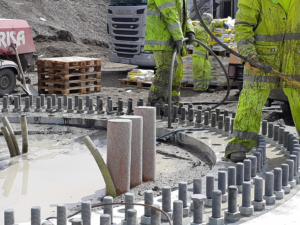Williams Anchors: Industry-Leading Anchoring Equipments for Boosted Architectural Assistance
Reliable Rock Anchors for Secure and Steady Foundations
In the realm of civil engineering, the duty of trustworthy rock supports can not be overemphasized, as they are essential in developing safe and secure and secure structures across a range of applications. Recognizing the different kinds of rock supports, their certain applications, and the intricacies of installment and upkeep is vital for optimizing their efficiency.
Kinds of Rock Anchors

Passive anchors depend on the weight of the framework and the surrounding dirt or rock to give resistance. Active anchors, on the other hand, entail the application of tension with a high-strength wire or rod, producing a pre-stressed condition in the support - Williams Anchors.
Grouted supports are an additional substantial category, where a steel bar or cable television is put into a pierced hole, adhered to by a cementitious cement. When treated, the grout bonds with the surrounding rock, producing a robust anchoring system. Each kind of rock anchor supplies distinct advantages based upon the particular geological problems and architectural demands, therefore playing a vital duty in the total stability and long life of created centers.
Applications in Building
Rock anchors play an essential role in different construction applications, offering vital support and stability in diverse settings. These innovative services are made use of in projects ranging from large facilities developments to smaller sized residential structures. One of the primary applications of rock anchors remains in the stablizing of inclines and keeping walls, where they aid stop soil erosion and keep architectural integrity.
Furthermore, rock anchors contribute in securing structures for bridges, tunnels, and skyscraper buildings, ensuring they can endure lateral pressures such as wind and seismic task. Their adaptability enables installment in challenging geological problems, making them excellent for jobs in mountainous or rough surfaces.

Secret Choice Requirements
Picking the proper rock anchor for a details application requires mindful consideration of a number of key standards. Firstly, the geological conditions of the site must be completely assessed. Recognizing rock kind, toughness, and security is vital to make certain that the anchor will do efficiently under lots conditions.

One more essential factor is the deterioration resistance of the support products. In environments revealed to dampness or chemicals, utilizing corrosion-resistant materials will certainly lengthen the life-span of the anchors and maintain click here for more info structural stability in time.
Additionally, the support's installment approach must straighten with the project's needs and constraints. Relieve of installation, in addition to the possible effect on bordering frameworks, must be considered.
Setup Methods
Efficient installation strategies are critical for the successful efficiency of rock anchors. Proper installment makes sure that the supports accomplish the desired load-bearing capability and security within the geological problems. The primary step in the setup procedure involves site analysis, where geological studies identify the rock kind, condition, and any type of possible difficulties.
Once dig this the website is examined, the proper drilling method must be selected-- options consist of rotating boring, diamond exploration, or percussion drilling. The choice relies on rock hardness and environmental considerations. Accurate boring deepness and angle are vital to ensure that the anchors line up with architectural demands and tons distribution.
After drilling, the following phase includes cleaning the borehole to eliminate debris, which can jeopardize bond strength. Following this, the anchor is put, and if called for, a cement or material is infused to boost adhesion. The treating time of these materials need to be followed, making sure that the anchors attain complete strength before any kind of tons is used.
Maintenance and Inspection
Correct upkeep and inspection of rock anchors are important to guarantee their long-term performance and reliability (Williams Anchors). Regular analyses assist identify any type of possible problems, such as deterioration, variation, have a peek here or structural fatigue that might jeopardize the honesty of the anchoring system
Routine inspections should be performed at defined periods, taking into consideration environmental elements and the specific application of the rock supports. Visual examinations must concentrate on the revealed areas of the anchors, checking for indicators of corrosion, cracks, or various other anomalies. In addition, it is essential to evaluate the bordering geological conditions to discover any kind of changes in soil or rock that may influence support performance.
Sometimes, more advanced methods such as lots testing or non-destructive screening may be warranted to identify the supports' load-bearing capability and total wellness. Appropriate paperwork of evaluation findings, upkeep activities, and any repairs or substitutes done is vital for continuous analysis and compliance with industry criteria.
Verdict
Finally, reputable rock supports play a critical function in guaranteeing safe and secure and secure structures across different building and construction applications. By effectively transferring loads and improving security against side pressures, these anchors contribute dramatically to the longevity and stability of structures such as bridges, passages, and keeping wall surfaces. Strategic selection, installation, and maintenance of rock supports are crucial for optimizing performance and guarding public safety and security, inevitably emphasizing their value in modern-day engineering practices.